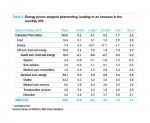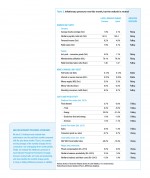Inflation
Scorecard
After falling for two consecutive months, the latest AIER Inflationary Pressures Scorecard indicates a neutral level for the months ahead (Table 2). Although 10 indicators suggest increasing inflation, up from seven last month, 11 out of 23 point to falling pressure.
Our analysis of demand and supply supports this reading. Higher growth in average hourly earnings was offset by a slowdown in personal income, which includes not only wages but also other forms of income, such as interest, dividends, rents, and so on. Weakened retail sales, which restrain inflation, were offset by slower gains in industrial production, which reduces supply growth and increases pressure.
Money/credit indicators, from interest rates to the money supply to consumer credit, have not changed from last month in their effect on inflation.
The producer price index, a measure of prices received by producers, fell for all goods and services, restraining inflationary pressure. But this was offset by higher wage growth and lower productivity gains, both pointing to rising pressure.
Consumer Price Index Analysis
The Consumer Price Index’s 0.2 percent rise in October came mainly from a 0.3 percent increase in energy prices. Energy rose after falling 4.7 percent in September and 2 percent in August. Over the longer term, however, the trend in energy prices remained mostly unchanged. Energy prices dropped 23.1 percent on an annual basis over the three months through October and were 17.1 percent lower than a year ago (Table 3).
Food prices continued to climb, but at a slower 0.1 percent pace compared with a 0.4 percent September gain. Households have been paying steadily higher prices for food since March. Over the past five years, food prices have increased at an annualized 2.5 percent rate, even surpassing services (excluding energy), which posted an annualized growth rate of 2.4 percent.
The core CPI, which excludes volatile food and energy prices, shows more stability than the overall CPI. It advanced 0.2 percent in October and has not had a monthly decline since January 2010. Over the longer term, from three months to 20 years, core CPI grew at a fairly constant rate, between 1.9 and 2 percent (Table 3).
Core goods, excluding food and energy, fell 0.1 percent in October. The main driver was apparel, which slid 0.8 percent, the biggest monthly drop this year. The next most significant factor was new vehicle prices, which slipped 0.2 percent, the fourth straight monthly decline.
Core services, which account for 59.1 percent of the CPI, rose faster than core goods, the core CPI, and the overall CPI not only over short term but also over the long run. Core services have been growing since the beginning of 2010. Medical care posted the largest gain for the month at 0.8 percent. In a longer-term perspective, however, education costs climbed at the fastest pace of all CPI components, rising 5.1 percent annually over the past 20 years.
Everyday Price Index
AIER’s Everyday Price Index (EPI) fell 0.6 percent in October after dropping 1 percent in September. Over the past 12 months the EPI has fallen 3 percent while the broader Consumer Price Index has risen 0.2 percent. The difference stems from the drop in energy prices. The EPI assigns a greater weight to energy.
Energy costs have fallen as commodity prices have weakened over the past year. Crude oil, the main input for gasoline, has plunged 44.7 percent, helping to drive gas prices down 27.8 percent. The cost of staying warm is falling, as well, with home heating oil sliding 32.9 percent. Natural gas prices have dropped even more, 34.4 percent, helping to push gas utility prices down 11 percent.
Grocery prices have also been restrained by commodity declines over the past year. Agriculture and livestock prices have fallen 10.9 percent, helping to hold groceries to a modest 0.7 percent gain. On the other hand, restaurants have not passed on lower input costs, instead raising prices 2.9 percent.
https://www.aier.org/epi
Next/Previous Section:
3. Inflation
6. Pulling It All Together/Appendix



